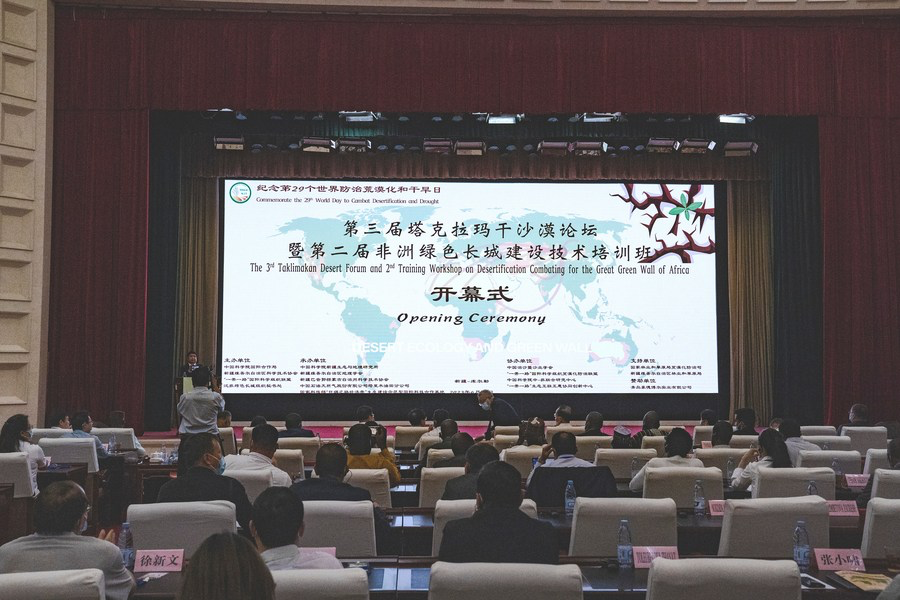Published: June 13,2023

This photo taken on June 10, 2023 shows the opening ceremony of the Third Taklimakan Desert Forum and the Second Training Workshop on Desertification Combating for the Great Green Wall of Africa in Urumqi, northwest China’s Xinjiang Uygur Autonomous Region. (Xinhua/Zhou Shengbin)
Over 180 researchers from 14 countries and regions gathered to communicate how to effectively prevent land degradation and desertification, especially in the Sahara Desert and the Taklimakan Desert.
“Alone we go fast, but together we go further,” said Marcelin Sanou, who works for the African initiative Great Green Wall, emphasizing the significance of international cooperation in combating desertification.
Sanou, chief of the planning, monitoring-evaluation and information management at the Pan-African Agency for the Great Green Wall, made the remarks at the 3rd Taklimakan Desert Forum held from Saturday to Monday in Korla, northwest China’s Xinjiang Uygur Autonomous Region. At the forum, over 180 researchers from 14 countries and regions gathered to communicate how to effectively prevent land degradation and desertification, especially in the Sahara Desert and the Taklimakan Desert — both are among the largest deserts in the world. The Great Green Wall initiative, launched by the African Union in 2007, with an overarching aim of planting a wall of trees across Africa at the southern edge of the Sahara Desert, is an African-led initiative to restore Africa’s degraded landscapes.
Sanou said that the Sahel region, a belt located on the southern border of the Sahara Desert, has long suffered from desertification, and one of the main goals of the Great Green Wall is to prevent desertification through multilateral cooperation. Diop Souleymane, chief of the geographic information system and database at the secretariat of the Pan-African Agency for the Great Green Wall, believes that China has made tremendous efforts to combat desertification, and Africa can draw inspiration from it to better address sustainable development and climate change issues. Jia Xiaoxia, program officer at the United Nations Convention to Combat Desertification (UNCCD), stated that the UNCCD is working hard to support affected parties in strengthening science-based decision-making. “We need joint efforts for facilitating scientific understanding, sharing knowledge and technology, and raising capacity to action,” Jia said.
The Taklimakan Desert, China’s largest desert, has been at the forefront of sand control and desertification research by Chinese scientists for over 60 years. Practices such as planting desert shelter forests and building sand-control barriers have been successfully implemented there. Zhang Yuanming, director of the Xinjiang Institute of Ecology and Geography (XIEG) with the Chinese Academy of Sciences, expected to “develop desertification control technologies suitable for Africa” and promote China-Africa green development cooperation based on collaborative research. Sanou mentioned that due to China’s unparalleled experience in sand control and combating desertification, the Pan-African Great Green Wall signed a memorandum of understanding with the XIEG in 2017, aiming to enhance cooperation in sand control.
Through such collaboration, China and Africa can share experiences and support each other in green development, he noted. Yang Wenbin, secretary-general of the China National Sand Control and Desert Industry Society, said that in the future, China and Africa could strengthen cooperation in sand control for highways and railways, groundwater replenishment, and high-value ecological industries. “Other than African countries in the Sahel region, we are also happy to engage in green cooperation in the Arab and Central Asian regions,” Yang said. Endrias Geta, Ethiopia’s state minister of irrigation and lowlands, told Xinhua that China’s support for the Great Green Wall is making a significant amount of land habitable again. “Millions of hectares of land have been rehabilitated due to this Chinese government support,” he said.
Xinhua
 Africa -China Review Africa -China Cooperation and Transformation
Africa -China Review Africa -China Cooperation and Transformation
